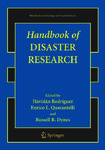| dc.description.abstract | Disasters create difficulties, even for those who study disasters. Much of that difficulty stems from the necessity to deal with concepts, which have popular meanings, and some of those meanings evoke moral and emotional reactions. Conceptual discussions about disaster related activities could evoke charges that researchers miss the point. Also, interest in disasters cuts across disciplinary lines so that one’s own disciplinary interests are considered critical while the interests of others are interesting but marginal. Quarantelli (2005) has recently described the social context in which the social scientific study of disaster has emerged, most of which is barely half a century old. He described the first sociological efforts to study disaster and how the Cold War, after World War II, began to raise questions about how American communities might react to enemy attacks. The larger social context prompted the initial efforts to look at peacetime disasters and indirectly led to the support of the Disaster Research Center. The idea of the Disaster Research Center and, subsequently, what came to be known as DRC, was independently created by sociologists at The Ohio State University. The outline of this Handbook and the topics selected for attention draw heavily from the perspective of the DRC. This is less because the editors are from DRC, but more from the fact that much of the earliest social science disaster research was done at DRC. Some attention to disasters had of course preceded the Center’s existence, ranging from Prince’s doctoral dissertation (1920) on social change and disasters to Sorokin’s theoretical treatise (1942)tothefirstsystematicfieldstudiesundertakenbytheNationalOpinionResearchCenter (1949–1954) to the series of studies done at the National Academy of Sciences (1952–1960). However, for about two decades after those works, DRC undertook the only continuous and systematic research in the area, and produced the bulk of the publications that were written. Thus, the early history of disaster studies is to a large extent the history of DRC and its early graduates. As background, the book Organized Behavior in Disaster (Dynes, 1970) provides a description of the early work of the DRC and a review of prior disaster research. That review noted that there were four common usages of “disaster”: as an agent description, such as a hurricane, an explosion, a flood and, more recently, a terrorist attack; as physical damage, in terms of both structures and people; as social disruption, creating a series of problems for communitiesandnations;andfinally,perhapsthemostcommonusage,asnegativeevaluation, describing situations and people as being confused, bad, as well as unlucky, and any other combination of these evaluations possible. In many discussions, different meanings can occur interchangeably within the same sentence. For our purposes here, the central meaning of disaster is social disruption. | en_US |

